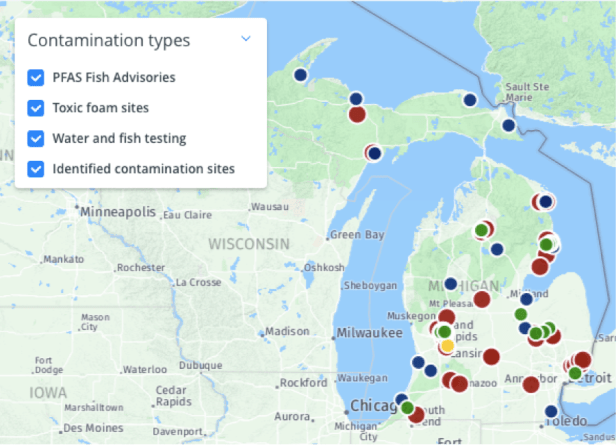Palo PFAS study finding ‘good news’
By Karen Bota | Daily News | February 29, 2020

Read the full article by Karen Bota (Daily News)
“IONIA — Around 50 people attended a community meeting Thursday night at Boyce Elementary School about the state’s investigation of PFAS in Palo groundwater.
Attendees came away with a reassuring message from the panel of presenters from the Michigan Department of Environment, Great Lakes and Energy (EGLE), the Michigan Department of Health and Human Services (DHHS), the Michigan Department of Agriculture and Rural Development, and the Ionia County Health Department: Don’t panic.
‘Keep calm and carry on,’ said DHHS Toxicologist Gary Klase, who was among the representatives updating residents on the PFAS study. ‘We’re finding a lot of good news’…
Because PFAS don’t break down easily, the chemicals persist when they seep into groundwater, lakes, rivers and streams, and in the human body. Most non-worker exposure to PFAS comes for drinking contaminated water or eating food with PFAS in it.
Although PFAS have been around a long time, not a lot is known for sure about how they impact human health, said Puneet Vij, another DHHS toxicologist. Some health studies have demonstrated that exposure to certain PFAS has been associated with interference with the body’s natural hormones, raised cholesterol levels, disruption of the immune system, lowering the chance of pregnancy, affecting birth weights, growth and learning of infants and older children and an increased risk of some cancers…
The statewide focus on PFAS started in the fall of 2017, when then Gov. Rick Snyder developed the Michigan PFAS Action Response Team, ‘very soon after they realized that Wolverine (World Wide) was a big problem,’ said Aaron Assmann of EGLE’s Remediation and Redevelopment division.
‘That’s when it became a statewide initiative to look for PFAS all across the state. All 95 of the wastewater treatment facilities across the state were tested,’ Assmann said. ‘The idea was, if we could find where it was, we could it trace back to the generators of it and work with them to reduce their contributions into the storm sewer water. It’s been a pretty successful program.’
The City of Ionia was part of an EGLE program to provide biosolids — that’s the sludge leftover when wastewater treatment is completed and sewage can’t be broken down any further — to farmers for land application, because biosolids are rich in nitrogen.
Ionia was also one of the 95 municipality water systems tested for PFAS, and its biosolids sample tested high. The city also had provided biosolids to the three fields around Palo, which is why that community was targeted by EGLE for sampling, said Stephanie Kammer of the Michigan Department of Environment, Great Lakes and Energy, Water Quality Division.
‘We came here because we had a specific source: the City of Ionia applied their biosolids,’ Kammer said. ‘It doesn’t mean it’s a huge impact here, it’s just we started here.’
EGLE partnered with the Ionia County Health Department and the Mid-Michigan District Health Department — the fields in question are on the county lines — and put together a plan to, starting in July 2019, sample the shallow wells near the field that had had the most biosolids applications. Based on EGLE’s findings, they expanded their sampling in September, moving outward. Now they are planning to enter their third phase of sampling. Kammer said they are focusing on Ionia County, because that’s where they had the most “hits” for PFAS.
‘We think the groundwater is flowing east, maybe northeast,’ Kammer said. ‘The question is: is it the fields or could it be something else? We just don’t know.’
Out of the 18 Palo wells tested so far, 11 had no PFAS detection, according to Vij. Seven had low levels of PFAS. Three of those were below the public health screening levels of the EGLE and federal Environmental Protection Agency (EPA) drinking water criteria. Four were above the level for one or more of the PFAS. Filters were distributed to all households that registered PFAS in their homes “to ensure residents’ safety while the investigation continues,” Vij added.
‘Drinking water screening levels are not the danger levels, and exceeding levels does not mean there’s a public health concern,’ he told the audience. ‘The guidelines are for public health actions. It tells us we need to look closer at the particular site’…”
This content provided by the PFAS Project.
Location:
Topics: